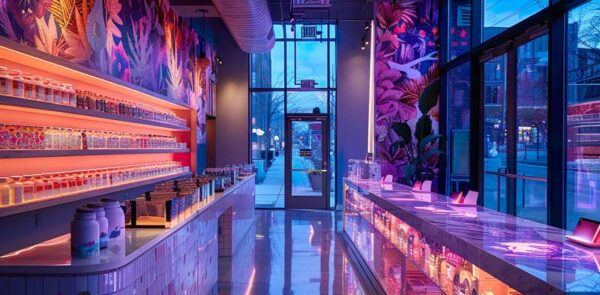
Jump to a section:
Our design team knows that a website design is more than just visual elements; numerous elements compete for attention: stunning visuals, compelling copy, intuitive navigation, and more. Amidst these, one often under-appreciated hero can make or break the user experience—white space. Also known as negative space, white space is the empty area between and around design elements. It may seem counterintuitive to value empty spaces on a page when trying to make your website look more professional, but let’s dive into why using white space is a must in website design.
1. Enhances Readability and Comprehension
One of the primary functions of white space is to improve the readability of your content. Dense blocks of text can overwhelm visitors, making finding and absorbing information challenging. By incorporating white space, we create breathing room for the text, which can significantly enhance comprehension and retention. Well-spaced paragraphs, headings, and bullet points guide the reader’s eye and break information into digestible chunks.
At Emulent, we prioritize readability in every design project. From our experience, a website cluttered with too much information can be a significant deterrent for users. We once worked with a client whose website had immense potential, but its dense text blocks were driving visitors away. Reworking the layout and incorporating more white space, we transformed their site into an inviting and easy-to-read experience. The result? Their bounce rate decreased by 20%, and user engagement increased substantially.
Moreover, white space isn’t just about aesthetics. It serves a functional purpose by making your content more approachable and less intimidating. When users find reading and understanding your content easy, they are likelier to stay longer, explore more pages, and absorb your message effectively. Whether it’s a blog post, product description, or a detailed report, well-utilized white space ensures your audience can focus on the content without feeling overwhelmed.
We understand the delicate balance between content and space. Our design philosophy is rooted in creating visually appealing and highly readable websites that capture and retain user attention.
2. Increases Focus and Attention
White space naturally directs a visitor’s attention to the most critical elements of a webpage. By strategically placing white space around key components such as headlines, images, or call-to-action buttons, we can highlight these elements and ensure they stand out. This technique is particularly effective in guiding user behavior, as it helps draw attention to what matters most, whether it’s an important announcement, a special offer, or a sign-up form.
At Emulent, we recognize the power of white space in enhancing focus and attention. In our projects, we often encounter clients with cluttered pages where vital information gets lost in the noise. By incorporating generous white space around key elements, we’ve seen remarkable improvements in user interaction. For example, one client’s call-to-action buttons were buried amidst dense content. After redesigning their layout to include more white space, these buttons became more prominent, leading to a 30% increase in click-through rates.
Effective use of white space doesn’t just beautify a webpage; it strategically enhances its functionality. It’s akin to a spotlight in a theater, directing the audience’s gaze to the main act. This “spotlight” effect on a webpage ensures that users can quickly identify and focus on critical information or actions. Whether it’s making a purchase, signing up for a newsletter, or simply finding contact information, white space ensures these elements are easily accessible and noticeable.
We believe that less is more. Our design approach leverages white space to create clear, focused user pathways. By eliminating unnecessary clutter and highlighting essential elements, we craft websites that look elegant and drive user engagement and conversions.
3. Improves Aesthetic Appeal
A cluttered website can feel chaotic and uninviting, while a design that uses white space appears clean, organized, and professional. Aesthetic appeal plays a crucial role in how users perceive your brand. Websites with ample white space tend to feel more modern and sophisticated. This minimalist approach aligns with contemporary design trends and helps build trust and credibility with visitors.
At Emulent, we’ve seen firsthand how white space transforms a website’s aesthetic appeal. One of our clients came to us with a website that felt overly busy and outdated. By integrating white space, we could give their site a fresh, contemporary look that resonated with their audience. The clean, organized design improved user engagement and led to more positive feedback about the brand’s professionalism and reliability.
The visual impact of white space goes beyond mere beauty; it creates a sense of calm and order. When users visit a website with a well-balanced design, they are more likely to feel comfortable and spend more time exploring. This positive experience can translate into increased trust and a stronger connection with your brand. In a world where first impressions are often made online, the aesthetic appeal facilitated by white space can be a crucial differentiator.
Our design philosophy emphasizes simplicity and elegance. We believe that white space is not wasted space but an essential component of effective web design. By carefully balancing content and space, we create visually appealing websites that capture the essence of our client’s brands and provide an enjoyable user experience.
4. Enhances User Experience
User experience (UX) is at the heart of effective web design. White space contributes significantly to a positive UX by making websites more navigable and less overwhelming. When users can easily find what they’re looking for without feeling bombarded by too much information or too many visual elements, they’re more likely to have a pleasant experience and stay longer on the site. This can lead to higher engagement rates and lower bounce rates.
At Emulent, we understand white space’s pivotal role in enhancing user experience. We’ve worked with numerous clients who initially struggled with high bounce rates and low user engagement due to cluttered website designs. By rethinking their layouts to include more white space, we transformed their sites into more user-friendly environments. For instance, one client saw a 25% increase in average session duration after we simplified their design with more strategic white space.
White space reduces cognitive load, making it easier for users to process information and navigate the site. This simplicity fosters a more intuitive browsing experience, allowing users to focus on the content and actions that matter most. In essence, white space acts as a guide, leading users through the site seamlessly and enjoyably.
Our design strategy is centered around creating exceptional user experiences. We believe the right balance of content and white space can turn a good website into a great one. By prioritizing white space, we ensure that our designs are visually appealing and easy to use, resulting in happier visitors and better overall performance for our clients’ websites.
5. Facilitates Visual Hierarchy
Creating a clear visual hierarchy is essential for guiding users through your content logically and intuitively. White space is a powerful tool for establishing this hierarchy. By varying the amount of space around different elements, you can indicate their importance and relationship to one another. For instance, more space around a headline can signify its importance, while grouping related items with less space can show their connection.
At Emulent, we often emphasize the importance of visual hierarchy to our clients. One project involved a client whose website lacked a clear structure, making it difficult for users to navigate and find relevant information. We created a more defined hierarchy that highlighted key sections and content by incorporating strategic white space. The result was a more intuitive browsing experience that led to a 40% increase in user satisfaction.
White space helps users understand the flow of information on a page. It allows us to create focal points that first draw attention to the most critical elements, such as headings, images, and call-to-action buttons. This structured approach ensures that users can quickly scan the page and grasp its main points without feeling overwhelmed.
We leverage white space to build clear, logical hierarchies that guide users seamlessly through our designs. We believe that a well-organized layout, enhanced by the strategic use of white space, can significantly improve the overall user experience. We aim to create websites where users can effortlessly find what they’re looking for, resulting in higher engagement and conversion rates.
6. Boosts Conversion Rates
Ultimately, most websites aim to convert visitors into customers, subscribers, or engaged users. White space can play a significant role in achieving this goal. A clean, well-organized design emphasizing key calls to action can lead to higher conversion rates. When users aren’t distracted by unnecessary clutter, they’re more likely to focus on and complete desired actions, such as filling out a form or purchasing.
At Emulent, we’ve seen how white space can dramatically impact conversion rates. For instance, one of our clients struggled with low conversion rates on their e-commerce site. The product pages were cluttered with too much information and competing elements, making it difficult for visitors to focus on the purchase process. By redesigning the pages to include white space around product images, descriptions, and call-to-action buttons, we created a more streamlined and inviting user experience. This change led to a remarkable 35% increase in conversion rates within the first month.
White space helps direct the user’s attention to the most critical elements of a page, ensuring that the primary calls to action are visible and compelling. This focus is crucial in guiding users toward the desired actions, whether signing up for a newsletter, requesting a quote, or completing a purchase.
We understand the power of simplicity in driving conversions. Our design philosophy incorporates ample white space to create clear, focused user pathways. By eliminating distractions and highlighting essential elements, we craft websites that look aesthetically pleasing and effectively guide users toward conversion. This approach has consistently helped our clients achieve their business goals and improve their website performance.
7. Enhances Mobile Usability
With the increasing use of mobile devices to access the internet, responsive design is more critical than ever. White space is especially important for mobile usability. Small screens require careful consideration of spacing to ensure that touch targets are easily tappable and that content is readable without excessive zooming or scrolling. Effective use of white space can make mobile navigation smoother and more intuitive.
At Emulent, we prioritize mobile usability in all our designs. We’ve worked with numerous clients to optimize their websites for mobile devices, ensuring that users have a seamless experience regardless of screen size. For example, a recent client’s site had dense content and small touch targets that frustrated mobile users. We redesigning their site with more white space improved the touch target spacing and readability, leading to a 50% decrease in mobile bounce rates and significantly improved user satisfaction.
White space on mobile devices is a buffer, preventing users from feeling overwhelmed by too much information on a small screen. It also reduces the likelihood of accidental clicks, enhancing the overall user experience. By creating ample breathing room around buttons, links, and other interactive elements, we ensure that users can navigate the site with ease and precision.
We understand the unique challenges of mobile design. Our approach includes strategically incorporating white space to enhance mobile usability. We believe that a clean, uncluttered design is key to providing a positive mobile experience. By focusing on user-friendly layouts and ensuring that all elements are easily accessible, we help our clients achieve higher engagement and satisfaction among their mobile users. This attention to detail in mobile design is crucial for maintaining a competitive edge in today’s digital landscape.
Conclusion
At Emulent, we believe that great web design goes beyond just looking good—creating an exceptional user experience that drives engagement and conversions. White space is a critical component in achieving this balance. As designers, we embrace the power of white space to craft websites that are beautiful, highly functional, and user-friendly.
If you want to elevate your web presence, let’s connect and create a clean, effective design that stands out in the digital landscape.


